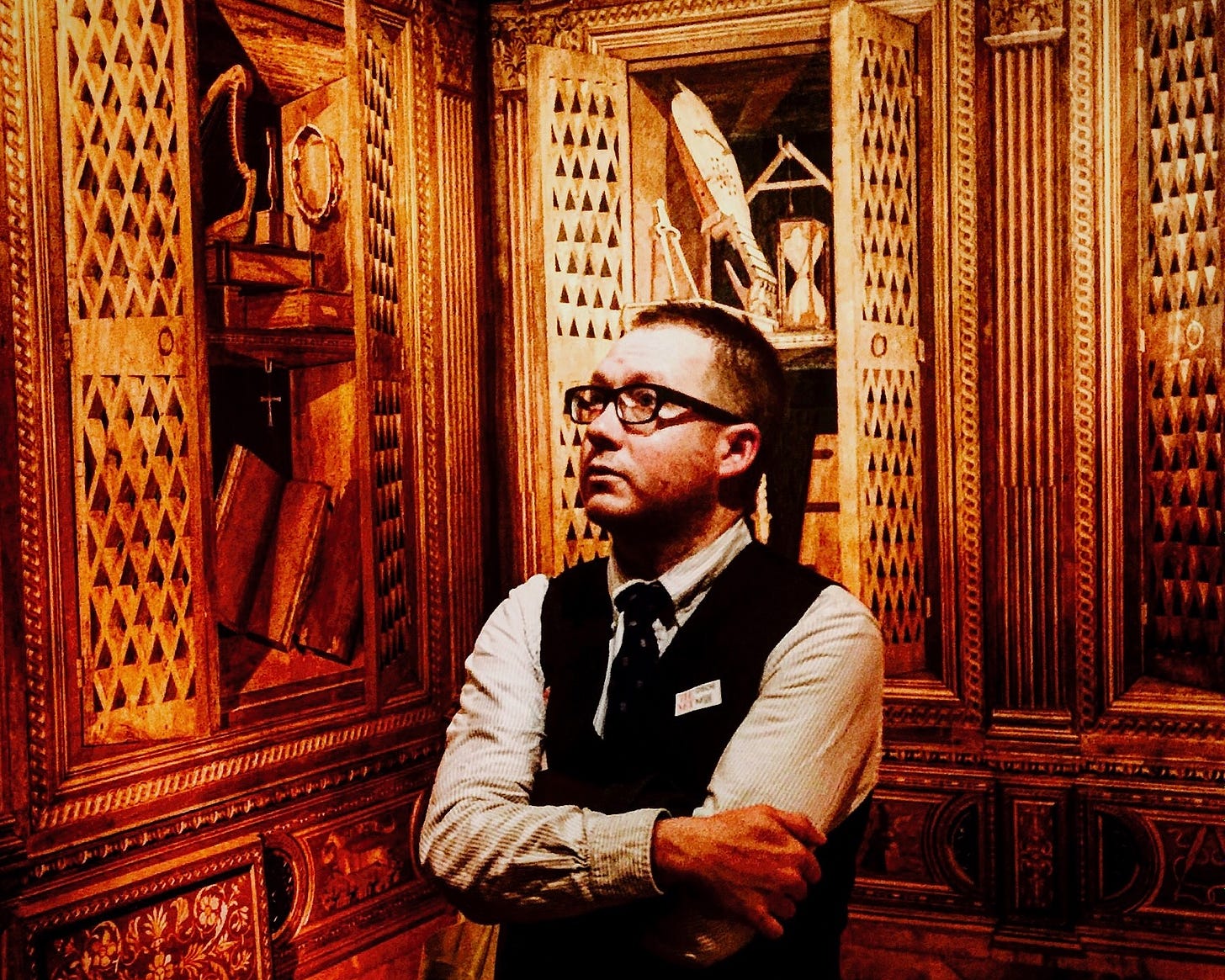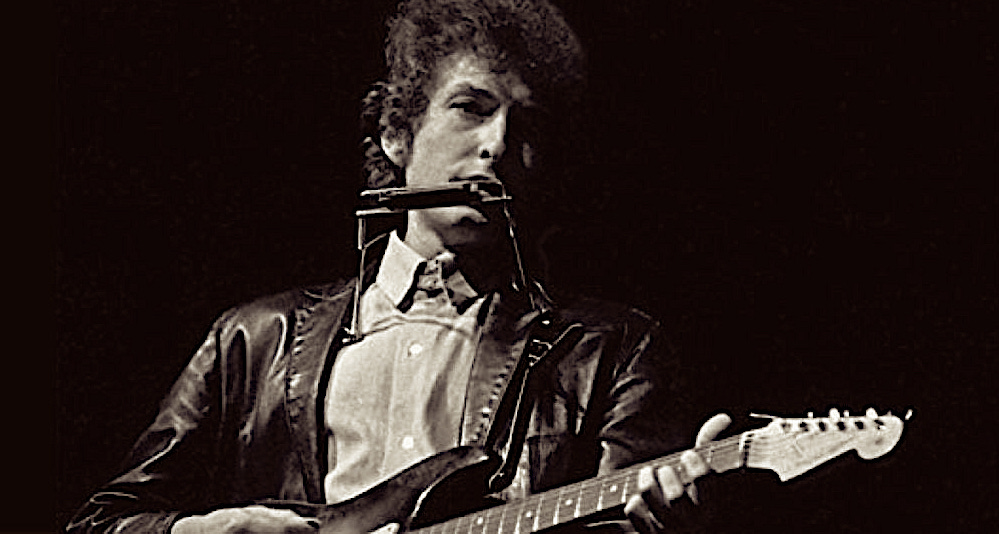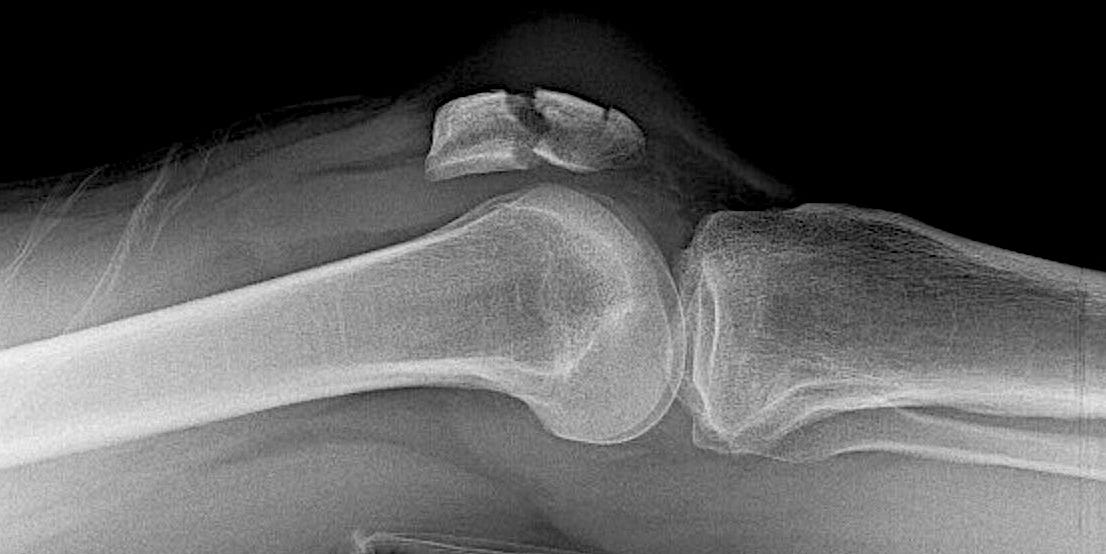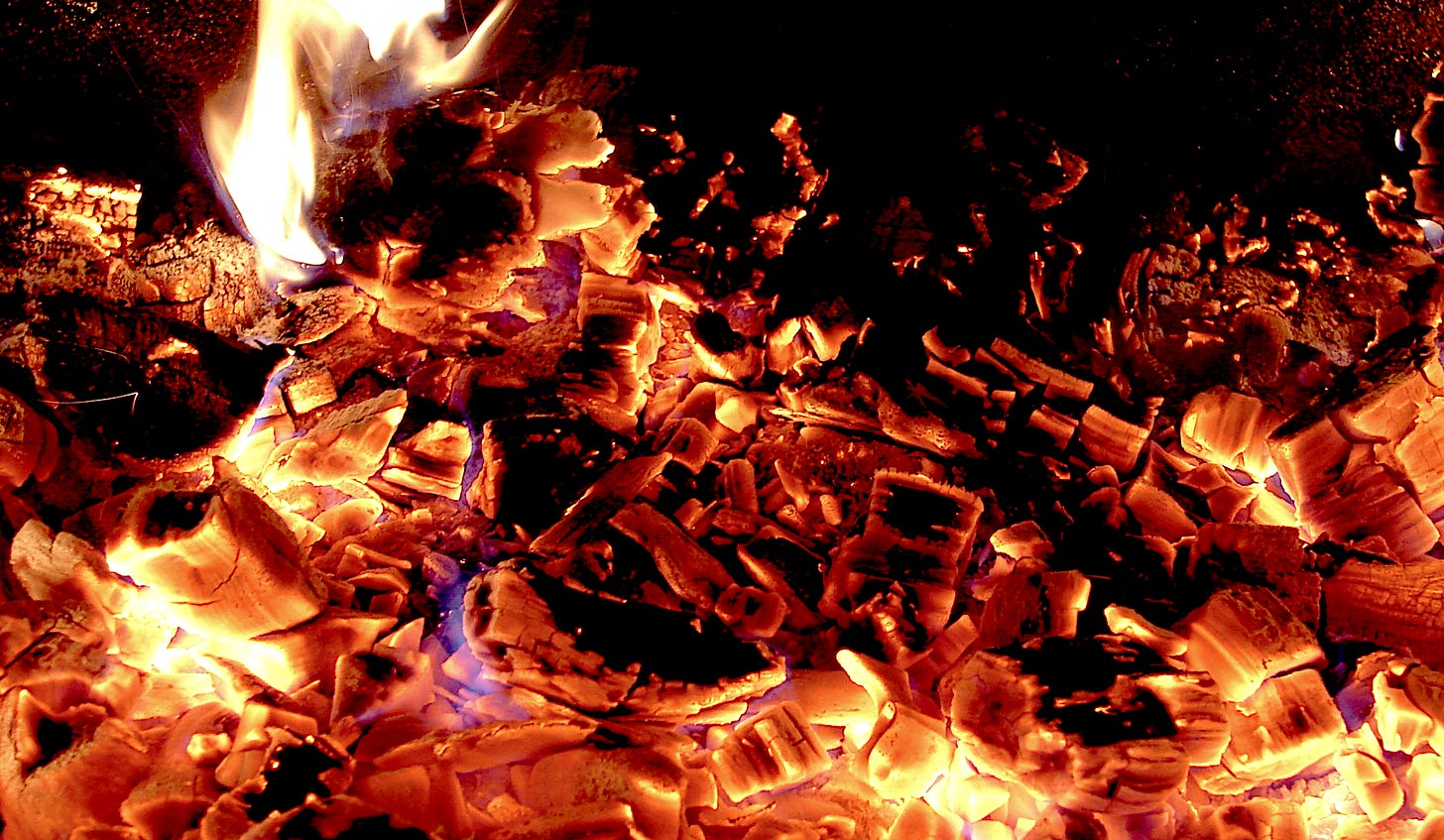Edited by Talia Lavin
A manic episode begins with a stirring, followed by a spark, like seemingly dormant embers catching fire. I first experienced this sensation almost seven years ago, in February 2016. My job at Details magazine had ended unexpectedly several months before (along with the entire publication) and I’d decided to use my new-found free time and limited severance to read, wander New York, and try and kick-start some kind of book project. What I needed was an idea. What I needed was inspiration.
So I set about constructing my own inspiration machine. I filled my head with Beethoven and frantically trudged through Manhattan seeking … enlightenment … epiphany … transcendence … something.
I found it in the Metropolitan Museum of Art, which, really, is as good a place as any, and better than most. Late on February 20, 2016, in the Gubbio Studiolo—designed by the artist Francesco di Georgio Martini for Federigo de Montefeltro, Duke of Urbino, in 1578—I had my spark, my Damascene flash. Reading a few details about the small, wood-paneled room’s provenance, it was as if everything I’d ever read about the Italian Renaissance flooded back and was now at my fingertips.
For context, I’d recently been reading about both di Giorgio and Duke Federigo, albeit separately. Di Giorgio is credited with introducing Leonardo da Vinci to the concept of the Vitruvian Man in the 1490s. Duke Federigo had recently been exposed—over 500 years after the fact—as a major player in the Pazzi Conspiracy to assassinate Florence’s leaders, Lorenzo and Giuliano de Medici, in 1478. Which was two years after Leonardo was arrested for homosexuality in Florence. Which was also where, as the information plaque on the wall revealed, the intarsia panels had been manufactured the same year as the assassination. That meant that Leonardo could have been introduced to di Giorgio over a decade earlier than assumed; it also put Duke Federigo’s representative in Florence during the planning of the Pazzi Conspiracy. If I could tie this together into logical alternate history, well then…
I had my book! I had all the raw material, anyway—it was just a matter of weaving it all together. How hard could that be? (Reader, it remains unwoven.)
It felt like I’d solved the Sphinx’s riddle, or been bit by a radioactive spider: I had gone seeking inspiration, and found it. I’ve never felt quite so alive and bursting with possibility as I was in those early days. I was a superhero: smarter, quicker, funnier, and seemingly more productive than I ever thought possible.
That first episode lasted a little over a week, though I would only later come to understand that it was mania. On the contrary—I thought I’d been touched by the Muse. My friends knew better, though, and one gave me a copy of Kay Redfield Jamison’s Touched with Fire: Manic-Depressive Illness and the Artistic Temperament. The book hit me with a cold blast of recognition; what she described in her book was precisely what I’d been experiencing: “fierce energy, high mood, and quick intelligence; a sense of the visionary and the grand; a restless and feverish temperament.” At the time, I took the book as a guide to all one could achieve with bipolar disorder, which seemed more like a blessing than a curse if managed correctly.
Maybe, in certain circumstances, that’s the case. Bipolar disorder helped inspire the paintings of Van Gogh, the poetry of Burns, and the music of Schubert. The flip side—the other pole, as it were—is that none lived to see 40. I didn’t have my first episode until I was 38.
In March, 2016, my second manic episode hit, just a month after the first. Thanks, in part, to Redfield Jamison’s book, I had a slightly better idea of what I was dealing with. I figured if I could suss out the rules of the game, I might be able to lock myself into this new super-genius matrix permanently.
This was around the time that I read a New Yorker piece that David Remnick had written about Bob Dylan a few months before. It focused on productivity, in particular Dylan’s “Hot Hand” in the mid-60s, one of the more incredible creative eruptions of the twentieth century. I had always been astounded by Remnick’s own level of productivity, so this seemed like a good pairing. As I read, I felt that familiar shiver of recognition. Given the bottomless wellspring of energy from which I was now able to draw, I began to consider the possibility that Dylan and Remnick had been similarly touched. In fact, maybe all super-achievers throughout history had been granted access to this same reservoir of inspiration that I now found myself soaking in. Was this is what people meant when they spoke of the Illuminati—a cabal of manic, inspired geniuses?
Reflecting on it now, this was clearly madness, but then it made all the sense in the world. After all, if my manic conjecture was indeed true, it didn’t take that huge a leap to assume that Remnick was recruiting me into this group through the subtext of his article about Dylan. The same way Remnick probably learned this truth through reading the words of Dylan about, say, Walt Whitman, who learned it through the work of William Blake or William Shakespeare or Hildegard of Bingen or Jesus Christ.
I don’t really remember how long I entertained the idea—that coded esoteric knowledge was being passed down to me in the pages of the New Yorker—but it wasn’t long. An hour maybe? The whole thing fell apart upon any close inspection, and that second manic episode remains the only time that my thinking has tipped over into delusion.
Which isn’t to say I’ve been free of regret. I torpedoed one of my closest friendships, and left others to languish out of my own discomfort, guilt, or shame. I’ve engaged in romantic entanglements I shouldn’t have. Spent money I didn’t have. Scheduled work meetings and interviews when I was in no condition to meet or interview with anyone. But I’ve never been committed or arrested, and I was able to develop certain tools to manage the mania, and ensure I stayed healthy, remembered to eat, and got enough sleep. As long as I had those tools at my disposal, I felt capable of handling whatever the illness threw at me. I also learned that without those tools I was at the illness’s mercy.
I couldn’t predict much about my particular brand of mental illness—each episode had characteristics all its own, and I went two years between my delusional second and my relatively mild third episode. But otherwise the schedule was consistent, seeming to coincide with the ecclesiastical calendar I’d grown up with as the son of an Episcopal priest. The fact that the mania generally locked in right around Lent had its own confusing psycho-spiritual repercussions. Forty days in the wilderness seemed like an apt metaphor for what I’d experienced.
In fact, my longest episode began on Ash Wednesday, 2020, then lasted for over two months, as Covid was raging through New York City. If a manic episode is a strange experience—and it is, among the strangest—then a manic episode in the heart of a global pandemic is stranger still. Given my surfeit of energy, the idea of quarantining in my tiny Brooklyn apartment was out of the question, but I also felt like I had a pretty good excuse to violate a few of the newly established societal norms settling over the city. So I walked.
The Sword and the Sandwich is a newsletter about serious extremism and equally serious sandwiches. Please consider supporting this work with a paid subscription:
In those two months I walked 1,000 miles, averaging over 16 miles a day as I sought to burn off energy and keep myself out of trouble. I walked to my office in the Village three times a week, stopping at the nearby Bowery Mission to prepare and serve meals for the homeless. I learned the location of every public bathroom in downtown Manhattan, washed my hands until they were raw, and explored parts of the city I’d never visited before. Like Will Smith in I Am Legend, I had the empty streets to myself, and prepared for each day like I was on some sort of expedition, complete with provisions, a first aid kit, extra batteries, and a spare pair of socks. Because local restaurants were desperate for any type of business, I treated each day like a culinary scavenger hunt, walking to Chinatown to hit up favorites like Peking Duck House, and other businesses that seemed to be taking the brunt of the early-Covid xenophobia.
It seemed as if the mania would never end, but I had convinced myself that I could manage it. My primary conclusion was that giving myself guardrails, rules, and restrictions helped me to cope, and even thrive. As long as I could exhaust myself physically and end each day with a clean conscience, I would sleep well, and that was the primary goal. So: do good, feel good. Self-interested altruism. It seemed like I had cracked some sort of code, and life seemed good, or about as good as things could in the midst of a 100-year catastrophe.
Things weren’t so good when I woke up with the familiar buzzing in January the following year. Once again, I was newly unemployed—the Village Voice had followed Details in shutting its doors, though I’d held on working on the Voice archives before finally being let go two days before Christmas. But thanks to the mania, instead of dread or depression I felt optimism at the prospect that this fresh shot of energy and inspiration might ignite the next phase of my life. So I got up, got out of bed, and set out to buy some bread. During the previous year’s marathon episode, still-warm daily bread from Le French Tart bakery in Carroll Gardens had sustained me, and I was eager to make a visit there my first task of the day.
Returning home with my fresh baguette, I might as well have had cartoon bluebirds guiding my path. Then, as a delivery man walked by carrying a load of boxes, a piece of paper flew off down the street. Because I was in my do-gooder mindset, I quickly spun on my heels to snag it. I don’t know if I tripped on the uneven paving, or merely lost my balance, but I went down hard, with my left knee taking the brunt of the impact. It cracked like a teacup.
Under the best of circumstances, a shattered kneecap would have been unpleasant. But not only was I in a manic episode while dealing with a horrific injury, when I lost my job I also lost my health insurance. I had heard enough horror stories about uninsured patients basically bankrupting themselves by calling an ambulance, so I ruled that out. Thankfully, I had friends in the neighborhood with a car, and they were able to deliver me to the emergency room.
If my previous episodes had been largely, if not overwhelmingly, positive, now the sensations were dread and despair. And pain. Nine years ago I fractured the same knee—the tibia, rather than the knee-cap—and subsequently developed an addiction to painkillers that ultimately sent me to rehab. So I would have to make do with extra-strength Tylenol rather than the prescription meds I might otherwise have leaned on.
It took several weeks and the help of my brother to untangle the Gordian knot of red tape and get insured, so that I could afford surgery. The pain was bad, but even worse was the fact that, because of the mania, I was unable to get any sleep. That meant one of the few opportunities for some kind of relief was beyond my grasp. This time, with my shattered kneecap, I didn’t have my primary tools, and I started to consider the possibility that maybe I couldn’t manage things on my own, after all.
Last October, Talia and I discussed the idea of addressing my experience with mental illness in a column. But bipolar disorder is a tricky thing, and it seems that in trying to pin it down and dissect it, I stirred up some of those manic embers and lit them anew. My first non-winter episode ultimately lasted for a month and a half, with mostly only minor collateral damage. Now that it’s subsided, it’s easier to get my thoughts down.
In the time since my first episode, a lot of the shame has been lifted when it comes to talking about bipolar disorder. Seven years ago, Kanye’s mental health demons were still just gossip. But as more and more people—celebs and writers alike—have opened up about their own struggles, it’s been easier to address my own. I have no trouble talking about it in my private life, but professional instability has made me reluctant to be fully transparent publicly. I don’t think being bipolar makes me any worse of a job candidate, but employers may not agree. That’s the primary reason I haven’t written about my condition before now.
Finding a job while also managing a mental illness is a challenge all too many Americans face. It’s a catch-22. You need a job to get the health insurance to manage your bipolar disorder, but bipolar disorder makes it difficult to get a job…so you can get health insurance…so you can manage your bipolar disorder.
Still, I would like to see my condition treated with more care and sensitivity by the industry I’ve dedicated my career to. It’s gotten better, but there’s still a hamfistedness to a lot of the headlines. Over the last couple decades there have been great pieces by Vanessa Grigoriadis in New York magazine, by Jennifer Egan in the Times, by Erica Schwiegershausen in the Cut. It’s been famously depicted on screen by Claire Danes in “Homeland,” among others. In December, Selena Gomez opened up about her struggles living with bipolar disorder in her Apple TV docuseries, My Mind and Me.
I assume that most bipolar people have their own tools, security blankets, and totems they turn to for comfort or ballast. For me, those include Bob Dylan, Beethoven and the Italian Renaissance, but also Walt Whitman and Robert Burns, the Grateful Dead and the Velvet Underground, Aaron Copland and Gustav Mahler, Patti Smith and Nina Simone, Joseph Mitchell and St. Clair McElway, Sherlock Holmes and Robin Hood, the Scottish Enlightenment and the eighties New York of my childhood.
Even with my tools and guardian angels, I recognize that the stakes have been raised in terms of my treatment. I’ve been seeing a therapist since long before my first episode, and I’ve been taking Lexapro even longer. I’m now on a mood stabilizer as well. According to the National Alliance on Mental Health, almost one in five people with bipolar disorder take their own lives, and I don’t want to end up a statistic on that particular ledger.
In the meantime, this has become the defining characteristic of my life, and I’m ready for that to change. Not that I ever expect to be “cured”—I’d just like for bipolar disorder to be something that I can manage, like my cholesterol. Or my anxiety and depression, for that matter. I’ve coped for years with both of those (though, in retrospect, “coped” may be a stretch, given the self-medication along the way.)
Mania is frequently likened to fire, which is both apt and personally ironic, given that I associate its onset with heavy coats, long underwear, and the dull cold of midwinter. (In addition to Touched with Fire, Redfield Jamison’s bibliography includes Robert Lowell: Setting the River on Fire and Fires in the Dark: Healing the Mind, the Oldest Branch of Medicine.) We rely on fire to keep us warm and to help guide us in the dark, but left unmanaged and unchecked it can reap destruction. Still, I’m hopeful. I’m hopeful that this new treatment helps me back to the life I once knew. Hopeful that I might find the stability and the steady employment I need to manage. Hopeful that my transparency here will make it easier for me to write more in the future. Hopeful that I can keep the embers of my mind from burning out, or from burning out of control.











Thanks for this, David. Your transparency and humanity are important not only for those who are trying to manage their bi-polar disorder, but for the people who love these folks. Our oldest adult daughter lives with us because she refuses to use medication and as a result can’t keep a job. We know we can’t force her to do anything; we simply hope that a stable environment and affordable rent will help her stabilize so she can begin to put the pieces of her life back together. She too is lucky; when manic she spends money she doesn’t have, which has gotten harder to do since she had to get rid of her credit cards. She is smart, kind, beloved by animals and small children. She has so much to offer. I think it is the loss of the potential of many of those with bi-polar that is hardest of all to accept.
My best to you and all who struggle. Your stories matter. Please keep telling yours.
This was brave to write, and inspiring to read. Thank you for sharing your story in such a way that many of us can see parts of our own lives, large or small, in it. We all have problems; what metters most is seeing them, and recognizing the commonality we have with others.